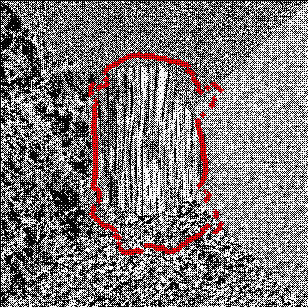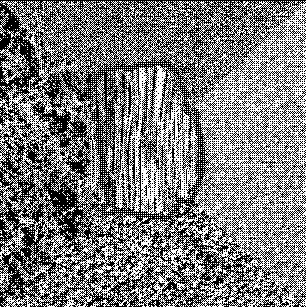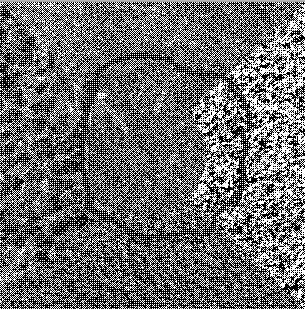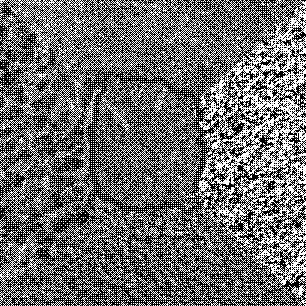

Figure 7: Result for gradient (first image) and AMDF (second image).





Figure 7: Result for gradient (first image) and AMDF (second image).
For the experimental evaluation on textured objects we have chosen a texture
image data base .
This database contains of 100 images of size
.
This database contains of 100 images of size  pixels.
In each image a textured circle with a radius of 100 pixels is located
in the middle of the image. Around the circle
four different ``background'' textures can be
found (see 5 for two examples).
The unique shape and position of the textured circle allows for
an easy and automatic evaluation of the contour extraction for different
texture energies. Additionally, we have morphed 38 of the
100 images, to get a non circular object. Thus, we can demonstrate
that the approach also works for arbitrary shaped contours.
pixels.
In each image a textured circle with a radius of 100 pixels is located
in the middle of the image. Around the circle
four different ``background'' textures can be
found (see 5 for two examples).
The unique shape and position of the textured circle allows for
an easy and automatic evaluation of the contour extraction for different
texture energies. Additionally, we have morphed 38 of the
100 images, to get a non circular object. Thus, we can demonstrate
that the approach also works for arbitrary shaped contours.


Figure 8: Results for gradient (first image) and kurtosis (second image).
In the experiments we have tested energies, which are based on
In 7 and 8 four example images are presented, which show, that for most textured images the image gradient is not suited for contour extraction and that texture energies are necessary. The results of the judgement function AMDF, skewness, variance and kurtosis are compared with the image gradient.
In 1 the results are shown for the contour extraction of the non--morphed circles. The mean pixel error is given in percent of the radius of the circle. The synthetic images of the test data base with artificially implanted circles probably explains the good results of the gradient, compared to the morphed, non--circular contours (see 7 and 8). In the morphed images the boundaries between the textured regions are more smooth. Thus, the detection of the contour by the gradient on this test data is less accurate.

Table 1: Results for contour extraction of 100 images (circle in the center
of the image with radius 100). The pixel error (mean, minimum, maximum)
is given in percent of the radius of the circle.
In 2 the time for contour extraction for the different judgement functions and different number of contour points are summarized. The contour has been extracted on a SGI Onyx with R10000 processor. The results show, that the contour extraction is possible within the image frame rate (40 msec).

Table 2: Computation time (in msec) for contour extraction (10, 100, and
360 contour points)
for different judgement functions. The window width has been 10 pixels,
the number of hypotheses has been set to 10.


